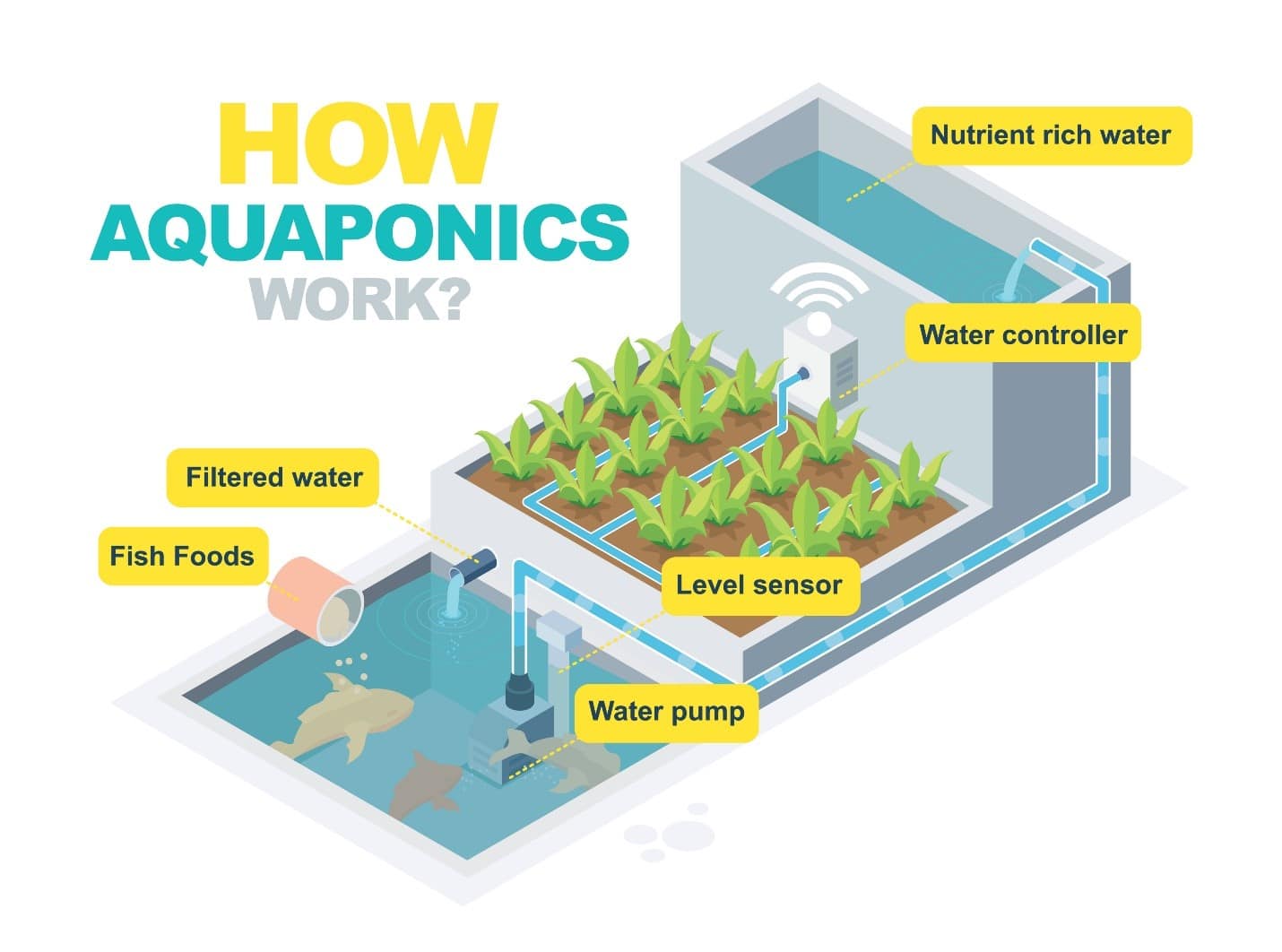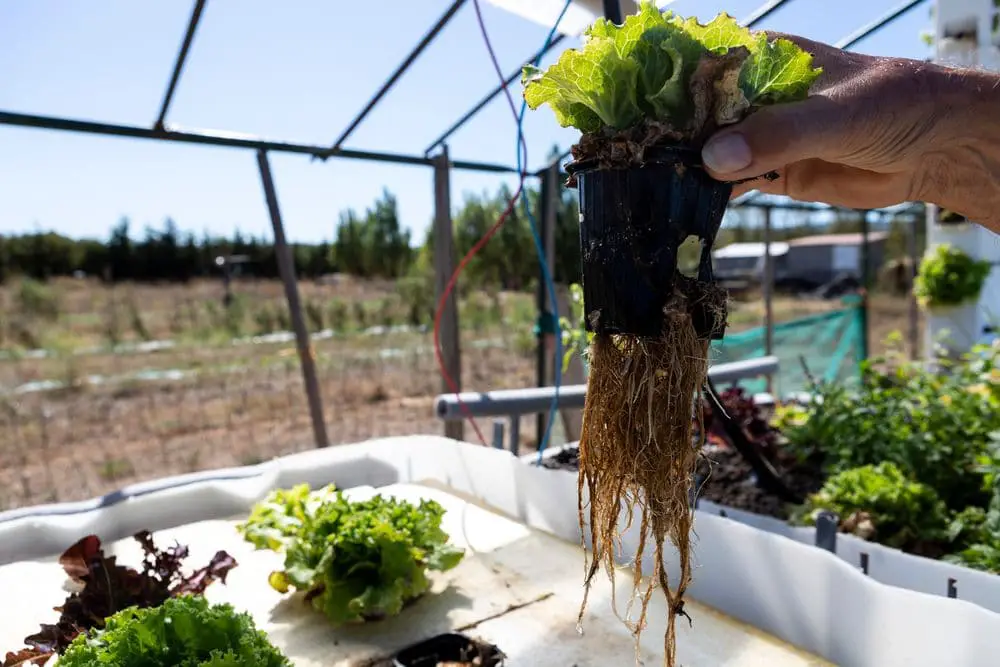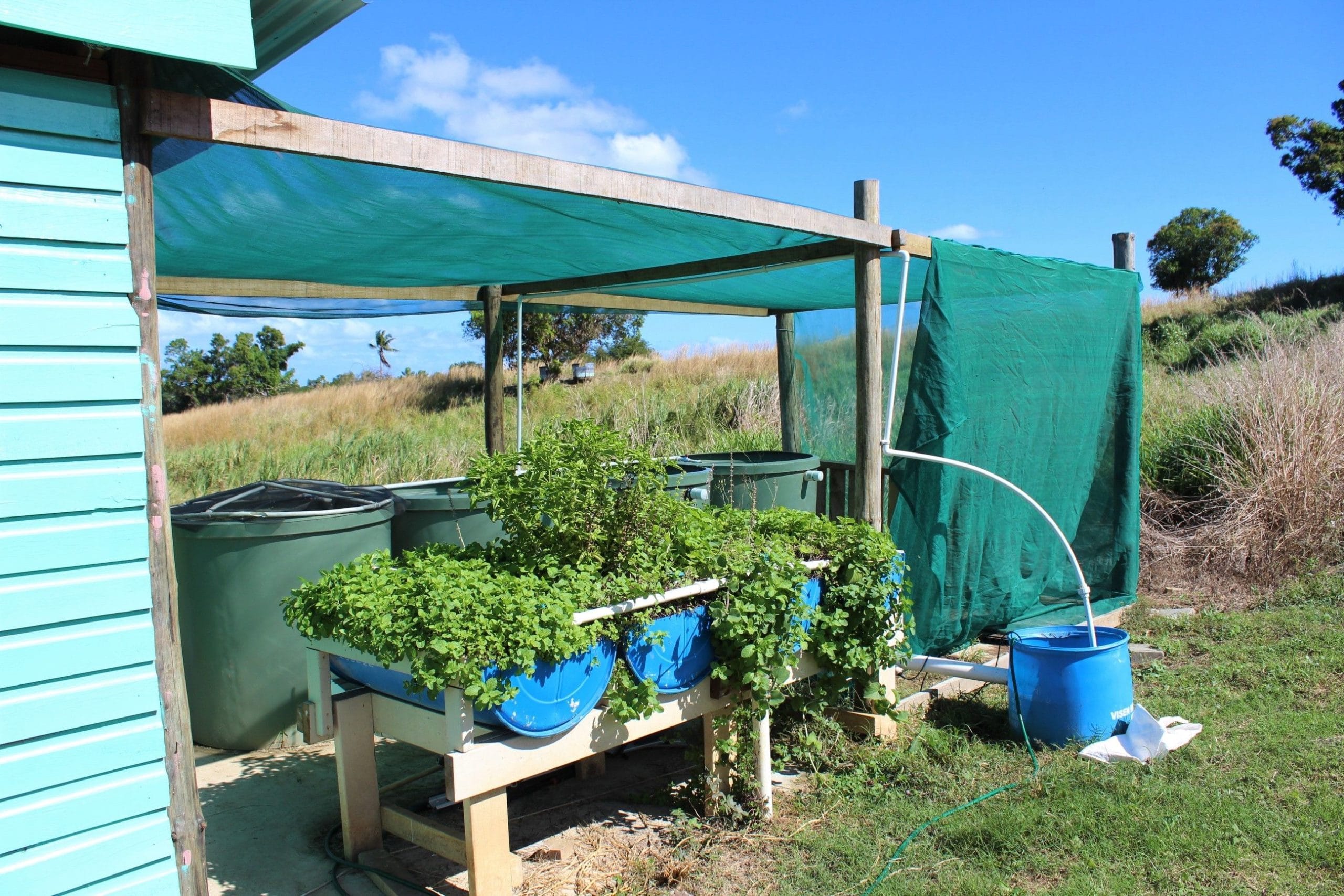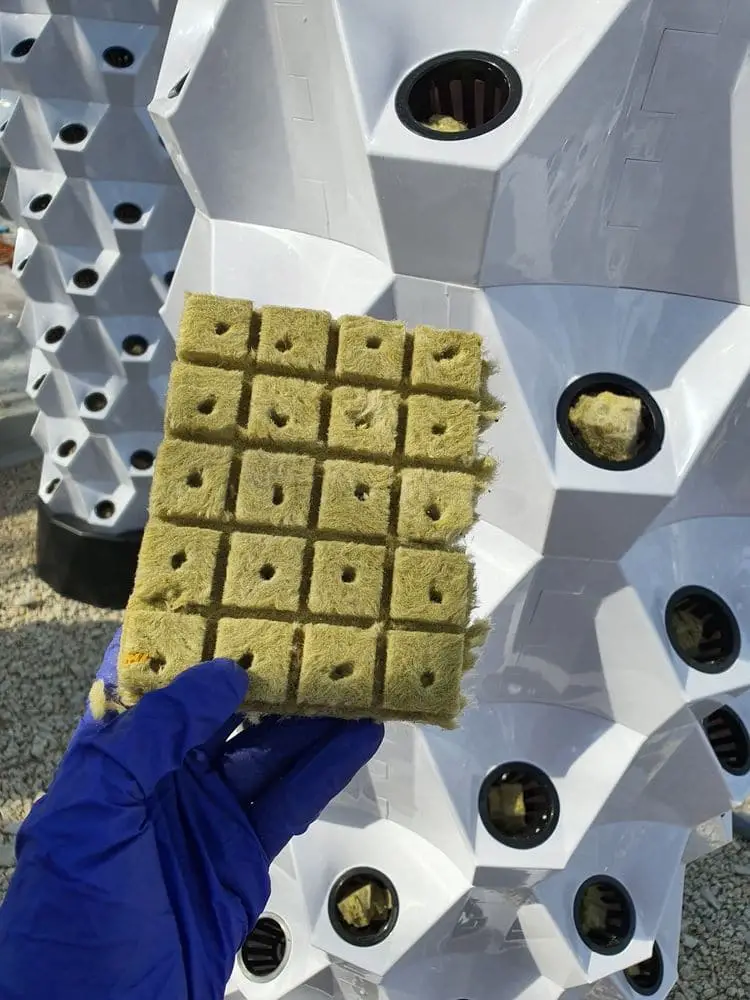Aquaponics Growbeds – For Beginners! Aquaponics is an eco-friendly, sustainable, and hassle-free way to produce food in your home. Growbeds are one of the most important components of an aquaponic system. The success of your aquaponics garden depends on your aquaponics growbeds.
In recent years, aquaponics has been an easy and fun way for beginners to grow vegetables and fish. The right grow beds will provide your plants with the space they need to grow and flourish. Below is everything you need to know to get started and feel like an expert!
What is an Aquaponic System?
Aquaponics combines aquaculture (fish farming) and hydronics (growing of plants in a nutrient solution instead of in the soil).
Plants and fish grow together in an aquaponic system with the help of beneficial bacteria. You can set up your aquaponics system in a small outdoor space.
This makes aquaponics ideal for urban farmers who want to grow their fresh fish and vegetables.
An aquaponic system consists of:
- A Fish tank
- Grow Beds
- Water Pump
- Light
- Bacteria
- Fish
- Plants
The right aquaponics growbeds will ensure your aquaponic system will run smoothly and, therefore, produce healthy fish and plants.
How does Aquaponics Work?

The plants in your aquaponic system get nutrients from fish and bacteria. Conversely, the plants clean the water for the fish. This is how it works:
1. You feed the fish and they produce waste that is rich in ammonia.
2. Water containing fish waste goes to the grow bed.
3. Bacteria in the grow bed convert ammonia and nitrites (fish waste) into nitrates (fertilizer) for your plants.
4. Nitrates are used for plant growth and clean and filter the water.
5. Clean water flows back to the fish tank.
6. The cycle repeats itself.
Plants in your aquaponic system are grown in grow beds. On the other hand, the fish are placed in the fish tank below the grow beds.
What are Growbeds?
Aquaponic growbeds are suitable waterproof containers that can hold the soilless medium (gravel, lava rock, hydroton) for your plants. Your plants will grow in the grow beds.
Good grow beds ensure your plants and fish are healthy and happy.
The size of your grow bed should be proportionate to the size of your fish tank.
The number of plants you can grow and how well they will flourish depends on the number of fish in your fish tank.
Too many fish or feeding them with too much fish food will produce too much ammonia and nitrates. If there are not enough growing media in your grow bed to absorb the nitrates, they will poison your fish.
If you do not have enough fish in the fish tank, there will be insufficient nitrate to feed your plants.
The Importance of Growbeds
If you are not successful in growing plants in your aquaponic system, chances are there are issues with your grow beds. So, why are aquaponics growbeds important?
The Roots of your plant develop and grow in the grow bed. Having healthy plants translate to having a successful aquaponic system. A good grow bed has plenty of space to grow and spread, as well as feed on nutrients from the water.
A good grow bed speeds up the growth of your plants. Grow beds help your plants grow faster. This is so because when your plants receive rich nutrients, they grow and thrive quickly. A regulated water source also boosts the growth of your plants.
A grow bed processes solid waste. A grow bed helps break down fish waste before it goes back to the fish tank. Fish waste and other solid materials such as old roots are processed in the grow bed.
A grow bed helps filter the water. The grow bed helps get rid of debris and dirt from the water before it goes back to the fish tank. It, therefore, helps keep the water healthy and clean for the fish.
A grow bed functions as a biofilter. The grow cleans the water in the fish tank. Bacteria grow in the media in the grow bed and they help break down fish waste. The water in the tank, therefore, gets cleaned helping the fish to be healthy.
A grow bed stores water. Water can get stored in the growing media in the grow bed. This helps maintain the level of water in the fish tank.
A grow bed does not require weeding. Plants grown in grow beds cover the ground and keep weeds at bay.
A grow bed reduces the use of water. Plants grown in grow beds do not need too much water as those grown in soil.
The importance and benefits of growing plants in grow beds show it is easier and more convenient to grow plants in aquaponic systems than on the ground.
How to Choose the Right Aquaponics Growbeds
If you are a beginner in aquaponics, start with a 1:1 ratio of the fish tank to grow bed. This means that the quantity of your fish tank equals the entire volume of your grow beds. This will ensure sufficient filtration.
You should also choose a grow bed that is strong and thick enough to hold the weight of your plants, grow media, and the strength of regular filling and draining of water.
When choosing the material for your grow bed, make sure you will not have trouble dealing with it.
The grow bed should be deep enough to accommodate the root system of your plants. Of course, your grow bed should be waterproof so water will not leak while you are growing your plants.
Grow Bed Stands
Ideally, you should have about 12 inches of growing media in your grow bed so you can grow various plants. The stand of your aquaponics growbed should be able to carry that weight.

The grow bed is typically placed on top of the fish tank for shorter pipes so your aquaponics system does not consume too much space. In the same manner, your fish tank should also be able to support the weight of your grow bed.
Grow bed stands come in various sizes and shapes.
Siphons
A pump allows the water to flow from the fish tank to the grow bed. A siphon takes the water back from the grow bed to the fish tank.
Siphons can either be internal or external. Both approaches work but an internal siphon will work best for your aquaponics growbed because you will need fewer connections. You will also not worry about leaks.
Many people prefer external siphons when they are connecting two or more grow beds because it is cheaper than having a separate siphon for each grow bed. It is also easier to maintain.
Internal siphons are ideal for smaller aquaponics growbeds.
Growbed Height
Think of the plants you plan to grow in your grow bed. Will you be planting only leafy greens or do you want to grow different types of crops?
Your grow bed is a small artificial ecosystem with different zones, thus, as a standard, aquaponics growbeds are 12 inches deep.
Your grow bed should ideally have a depth of 12 inches. A deeper grow bed will be more difficult to maintain and a total waste. This depth can make sure the roots of your plants will be well supported.
A grow bed that is deeper than 12 inches will be more expensive because you will need to fill it with more growing media. It will be more difficult to maintain, too.
Grow Bed Size
The size of your grow bed should correspond to the size of your fish tank. All the water should be cycled from the fish tank into the growbeds and back to the fish tank within about one hour.
While not all the water is pumped in one go (because it will kill the fish), it is the basic principle to determine the size of your grow bed.
Aquaponic Grow Media
If you are a beginner in aquaponic gardening, bear in mind that your aquaponics growbeds are what will dictate your success or failure in this endeavor.
Here are some things you need to take into consideration when choosing the right grow media for your aquaponics system:
pH Neutral
Choose a material that does not have an effect on the pH neutral as it may hurt your fish and delay the development of your plants. Grow bed materials that are pH neutral allow the easy management of the pH level of your aquaponic system.
Smooth
Choose a grow bed that is safe to the touch so it will not cause any injuries to your hand.
Good Surface Area
The main function of the grow media is to provide a good surface area to allow the growth of bacteria. A large surface area allows more bacteria growth. It also allows the quick conversion of fish waste to nitrates.
Easy to Handle
You will be using your hands to place the grow media in your aquaponics garden. It can take a lot of time to prepare the grow media so they should be easy on your hands.
Many aquaponic gardeners love lava rocks because of their high porosity and size compared to other grow media. Their sharp edges, however, pose the risk of your hands getting cut if you are not careful.
You can choose other grow media that are easy on your hands or wear a pair of gloves.
Decomposition
Choose a grow media that will last longer and not decompose during or after the growing cycle.
Cost
Some grow beds are budget-friendly, and others are expensive. Your choice should also depend on your budget.
Taking into consideration the above factors, you are now ready to choose which of the following grow bed materials you want to work with.
Each of these grow bed materials has its pros and cons because no material is perfect.
Now that you know what to look for in a grow bed material, here are some of your options:
Coconut Fiber
Made from coconut husks, it comes in the form of piths and chips. Coconut fiber is almost similar to soil. It can control the nutrients in your aquaponics system so that your plants do not get too much or too little.
Coconut fiber retains water well, so you can water your plants less frequently.
Coconut fiber is pH neutral. It also has a great water-to-oxygen ratio allowing you to grow various crops without worrying about alkalinity or acidity.
Coconut fiber is an eco-friendly material. It is an organic material with excellent aeration.
This grow media, though has poor drainage and it can be difficult to mix with other grow media. It also tends to be uncompressed after several growing cycles.

Clay Pebbles
Clay pebbles are pH neutral and offer a lot of surface area for bacteria. They come with tiny holes so they can hold sufficient water. They also allow good draining and airflow.
This grow material is only suitable for certain plants. Besides, they are a bit expensive. Clay pebbles float during their initial use and can obstruct your aquaponics system.
Lava Rocks
Lava rocks are formed after hot lava cools. They are a great choice for grow media because they have a lot of surface area. The air pockets of the lava rocks provide additional area for bacteria growth.
Lava rocks are lightweight, provide good drainage, and are pH neutral. They, however, have sharp edges that can harm the roots of your plants or your hands.
Rockwool

Rockwool is a combination of limestone, coke, and volcanic rock that are melted at high temperatures and formed into slabs and blocks.
Rockwool has good aeration and water retention. It is sterile, too. More importantly, it is reusable as long as you disinfect and rinse it after each growing cycle.
Some types of Rockwool come with a high pH level.
Lightweight Expanded Clay Aggregates
Lightweight expanded clay aggregates are formed when clay pebbles are heated in special conditions. These grow media have excellent aeration and are highly porous. They have poor water retention but allow the best airflow.
Oasis Cubes
These are made from floral foam. They look like cubes and each contains nutrients, air, and water. They have above-average water retention and aeration. They are pH neutral and have open cell structures which are conducive to root growth.
Sand
Sand as a growing media assures good water retention. It is an ideal growing medium in the germination stage.
Sand, however, has poor aeration so it is difficult to mix with other growing media such as coconut or perlite. It is heavy and its small particles can block your aquaponics system.
Expandable Shale
Expandable shale is made from the crushing and heating of silicone-based shale. It is similar to lava rock in the sense that it has air pockets. Air pockets offer more surface area for bacteria growth.
Expandable shale is pH neutral. It has polished edges so they do not damage plant roots and are easier to handle. They are porous and lightweight, but us heavier than clay pebbles. It is more budget-friendly and reusable.
Gravel
Gravel can be found almost everywhere, thus it is an affordable grow media. It has larger particles than sand and looks similar to fragmented rocks. Gravel enhances aeration allowing the roots of your plants to get sufficient oxygen for photosynthesis.
Final Thoughts on Aquaponics Growbeds – For Beginners!
Much care and attention should be given to choosing and setting up your aquaponics growbeds. After all, the success of growing plants in an aquaponics system relies on your grow beds.
system relies on your grow beds.
Don’t forget to have fun with this project. The more you enjoy what you do – chances are, the more successful you’ll be!
Read More:
Top 11 Best Fish for Aquaponics
What Is Deep Water Culture In Aquaponics? An Appropriate Guide
What Are Some Pros and Cons of Aquaponics?
How Deep Should an Aquaponics Grow Bed Be?

